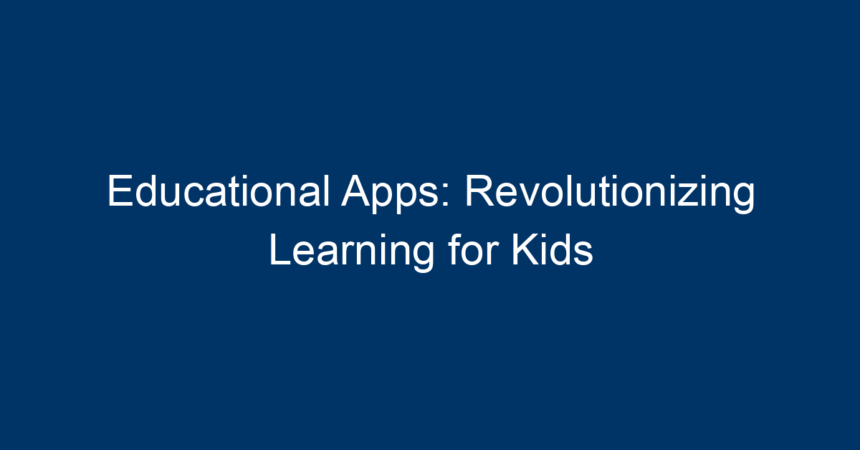In today’s fast-paced digital world, educational apps have emerged as a game-changer in the landscape of children’s learning. With smartphones and tablets becoming ubiquitous, accessing high-quality educational content has never been easier. Parents and educators alike are increasingly turning to technology to support traditional teaching methods, making learning more engaging and interactive for children. In this article, we will explore how these applications are transforming the educational experience for kids, the benefits they offer, and how to choose the right app for your child’s learning journey.
The Evolution of Learning: From Books to Apps
The evolution of educational resources has been remarkable. Traditional learning methods relied heavily on textbooks and classroom lectures, which, while effective, often lacked engagement. With the advent of educational apps, learning has become more interactive and personalized. Children can now learn at their own pace, revisit challenging concepts, and engage with gamified content that keeps them motivated.
The Rise of Educational Apps
The rise of educational apps can be attributed to several factors:
- Technology Accessibility: With the proliferation of devices like smartphones and tablets, children have unprecedented access to learning materials.
- Gamification: Many educational apps incorporate elements of gaming, making learning fun and rewarding.
- Diverse Learning Styles: Apps cater to visual, auditory, and kinesthetic learners through various interactive formats.
- Global Reach: Educational apps can connect children from different cultures, providing a broader perspective and inclusivity.
Benefits of Educational Apps for Kids
1. Personalized Learning Experience
One of the biggest advantages of educational apps is their ability to cater to individual learning styles and paces. Children can choose apps that align with their interests, allowing for a more engaging learning experience. Some platforms also offer adaptive learning technologies, adjusting the difficulty based on the child’s performance, ensuring they are adequately challenged without becoming frustrated.
2. Easy Access to Information
Educational apps provide instant access to a wealth of information. Unlike textbooks that may be outdated, apps can be frequently updated, ensuring that children have the most current knowledge at their fingertips. This immediacy encourages curiosity, allowing children to explore topics in-depth and at their own pace.
3. Interactive Learning
The interactive nature of educational apps turns passive learning into an active experience. Children can take quizzes, solve puzzles, and engage in simulations, making the learning process enjoyable and effective. This gamified approach helps reinforce concepts while holding the child’s attention.
4. Enhanced Retention
Research suggests that interactive learning can improve information retention. By actively engaging with content through videos, activities, and quizzes, children are more likely to remember what they’ve learned. Educational apps employ various multimedia components to make learning memorable.
5. Encourages Independence
With educational apps, children have the opportunity to learn independently. This not only fosters self-discipline but also encourages critical thinking and problem-solving skills. Kids become self-directed learners, which is an essential skill for academic and lifelong success.
Types of Educational Apps
As the demand for educational apps continues to grow, so does the variety available on the market. Here are some types of apps that cater to different learning needs:
1. Subject-Specific Apps
These apps focus on particular subjects like math, science, or language arts. They offer targeted exercises, quizzes, and interactive lessons. For example, apps like Khan Academy provide comprehensive resources across various subjects, making learning accessible to all ages.
2. Learning Games
Many apps are designed as games that teach essential skills while keeping children entertained. For instance, apps like Prodigy Math incorporate elements of role-playing games to make math practice fun.
3. Creative Expression Apps
Some apps focus on arts, music, and creativity, allowing children to express themselves. Apps like Toca Boca encourage imaginative play through interactive scenarios, while GarageBand teaches the basics of music creation.
4. Language Learning Apps
As global communication becomes increasingly essential, language learning apps like Duolingo and Rosetta Stone help children learn new languages through fun and interactive methods.
5. STEM Apps
STEM (Science, Technology, Engineering, Mathematics) apps are designed to inspire curiosity about these crucial fields. Apps like LightBot encourage programming skills through puzzles that require logical thinking, while apps like Osmo allow for hands-on learning experiences.
Choosing the Right Educational Apps
With thousands of educational apps available, it can be overwhelming for parents to choose the right ones. Here are some tips to guide you:
1. Assess Educational Value
Before downloading an app, check its educational value. Look for apps developed by educators or institutions known for establishing learning materials. Read reviews and ratings to gauge other parents’ and educators’ experiences.
2. User-Friendly Interface
Children, especially younger ones, benefit from simple layouts. An intuitive design makes navigation easier, allowing kids to focus on learning rather than struggling with technology.
3. Age Appropriateness
Ensure that the app is age-appropriate. This includes considering the complexity of the content and the themes presented. Many educational apps clearly state appropriate age ranges and target grade levels.
4. Screen Time Monitoring
Set limits on app usage to avoid excessive screen time. Encourage breaks and offline activities to ensure a balanced approach to learning.
5. Engage in Active Learning
It’s beneficial to engage with your child while they use educational apps. Ask questions, participate in activities, and encourage discussions about what they learn. This interaction reinforces learning and builds valuable connections.
The Future of Learning: Integrating Educational Apps into Education
As educational apps continue to evolve, they offer endless possibilities for enhancing learning. Schools and classrooms are already integrating technology to create blended learning environments. Teachers can utilize apps for homework, class projects, and interactive lessons, providing a more holistic approach to education.
1. Collaboration and Community Learning
Future trends indicate a rise in collaborative educational apps where students can learn together in virtual environments. This fosters community learning, encouraging teamwork and communication skills.
2. Virtual Reality and Augmented Reality
The integration of VR and AR in educational apps is on the rise. These technologies can provide immersive experiences that deepen understanding and engagement in subjects ranging from history to science.
3. Continuous Improvement through Feedback
As data science progresses, educational apps will become more sophisticated in adapting to individual learning needs. Personalization based on real-time feedback will optimize learning paths for each student.
Conclusion: Embrace the Future of Learning
In conclusion, educational apps are revolutionizing how kids learn by making education more accessible, interactive, and personalized. With countless resources at their fingertips, children can embark on a journey of self-directed learning, exploring subjects that interest them most. By choosing the right apps, setting boundaries on screen time, and actively engaging with your child’s learning, you can help them harness the full potential of educational technology.
As technology continues to advance, it’s essential to embrace these changes, preparing our children for a future that is as dynamic as the world around them. The beauty of educational apps lies in their ability to make learning fun and engaging, equipping young minds with the tools they need to thrive in an ever-changing world. So, take the plunge and explore the myriad of educational apps available today—your child’s educational journey awaits!




